
S.Warren. Designing organic syntheses
..pdf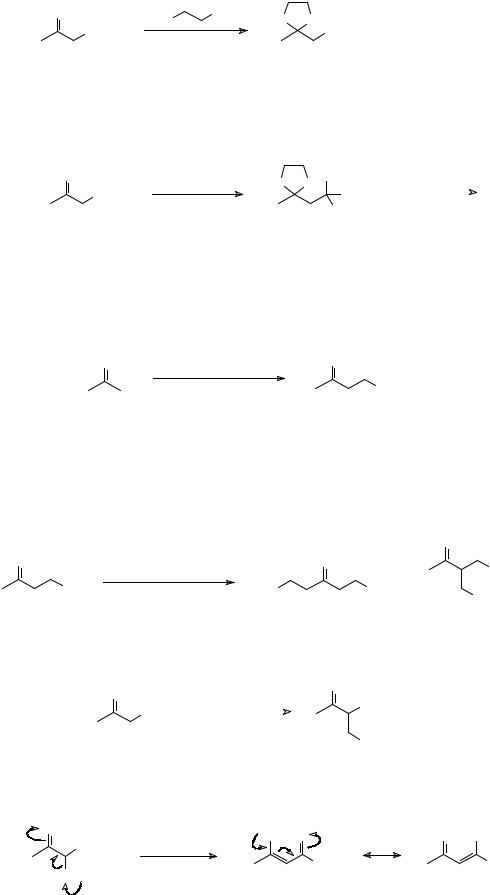
|
|
18 |
|
O |
HO |
|
OH |
|
|
O O |
|
|
CO2Et |
H+ |
CO2Et |
|
|
|
Now complete the synthesis.
If you're not sure of the mechanism of acetal formation or just want to know a bit more about acetals, read frames 1-21 and 62-64 of the Carbonyl Programme.
_______________________________________
51. |
|
O O OH |
H+, H2O |
|
O |
PhMgBr |
|||
CO2Et |
|
Ph |
|
TM 49 |
|
|
|||
|
|
|
||
|
|
Ph |
|
|
Any functional group can act as a protecting group providing it can easily be added and removed and providing of course that it doesn't react with the reagent! We shall meet more examples as we work through the programme.
_______________________________________
52. Sometimes, rather than protect one part of a molecule, it is better to activate another.
O |
base, PhCH2Br |
O |
Ph
This reaction gives only a poor yield. Why? Enolisation is involved: if you're not sure about this, see frames 169 ff of the Carbonyl Programme.
_______________________________________
53. Because the product is at least as reactive as the starting material, and further reaction occurs:
|
|
|
|
O |
O |
base, PhCH2Br |
|
O |
Ph |
|
|
|
||
|
Ph |
Ph |
Ph |
+ |
|
|
|
|
Ph |
We can't protect the carbonyl group without stopping the reaction, so we activate one position by adding a CO2Et group and using the ester A below, the synthetic equivalent of acetone, instead of acetone itself. Here is the reaction; draw a mechanism for it.
O |
|
- |
O |
|
|
|
|||
|
CO2Et |
1. EtO |
CO2Et |
|
|
|
|||
A |
2. PhCH2Br |
Ph |
||
|
||||
|
|
|||
|
|
|
_______________________________________
54.
1. |
O |
- O O |
|
O O- |
|
|
|||
|
|
CO2Et |
|
|
|
|
OEt |
A |
OEt |
|
H |
- |
|
|
|
|
|
||
|
|
OEt |
|
|
only this stable enolate A formed

|
|
19 |
- |
O O |
O |
2. |
|
CO2Et |
|
|
|
|
|
OEt |
 Ph Ph
Ph Ph Br
Br
Of course, we must now remove the activating group, CO2Et in this case, just as we had to remove the protecting group before. How might we do this?
_______________________________________
55. By hydrolysis and decarboxylation:
|
|
H |
|
|
O |
acid or |
O O |
OH |
O |
CO2Et |
|
- CO2 |
|
|
|
base |
|
O |
|
|
|
heat |
Ph |
|
Ph |
|
Ph |
Ph |
_______________________________________
56. This is then a general synthesis for ketones and the corresponding disconnection is
O |
O |
Br |
Ph |
- |
+ |
Ph |
B
The acetoacetate enolate ion (A in frame 54) is a reagent for the synthon B, the acetone anion. We shall discover how to add the CO2Et activating group later.
_______________________________________
57. Protection and activation give us a reagent for the synthon -CH2CO2H. We protect the acid as an ester and add another ester group as activation, giving malonic ester: CH2(CO2Et)2. How would you make TM 57?
TM 57
_______________________________________
58. Analysis:
-
|
CH2CO2H = CH2(CO2Et)2 |
|
|
|
|
CO2H |
Br |
FGI |
OH |
FGI |
CO2Et |
|
|
||||
Choosing this disconnection because we recognise a starting material easily made by a Diels-Alder reaction (cf. frame 22).
Synthesis:

20
CO2Et |
CO2Et |
1. LiAlH4 |
Br |
CH (CO Et) |
|
|
|
2 2 2 |
|
2. PBr3 |
- |
||
|
EtO , EtOH |
|||
|
|
|
||
CO2Et |
1. ester hydrolysis |
TM 57 |
||
CO2Et |
|
|
||
2. heat (- CO2) |
||||
|
||||
_______________________________________
59. Here is quite a difficult problem: to solve it you will need to use both protection and activation. Two hints: the disconnections are shown and you might like to start by thinking how you would make a cis olefin. How can you make TM 59?
O
TM 59
_______________________________________
60. Analysis: This cis olefin will presumably come from an acetylene: we can then use an acetylide anion:
O |
O |
O |
|
|
FGI |
- |
+ |
MeI |
|
|
|
|||
|
|
|
|
Now we can disconnect the ketone using our synthetic equivalent for the acetone anion:
O |
O |
Br |
|
- |
+ |
||
|
|||
|
CO2Et |
|
Synthesis: (Crombie, J. Chem. Soc. (C), 1969, 1016). The acetylenic bromide corresponding to allyl bromide is called propargyl bromide and is reactive and readily available. We shall need to protect the ketone before we make the acetylene anion. It turns out that protection and decarboxylation can be done in one step.
O |
1. EtO- |
O |
|
HO |
OH |
NaNH2 |
|
|
|
||||
CO2Me |
|
|
|
|
|
O O |
|
|
|
H+ |
|
MeI |
|
2. |
Br |
|
CO2Me |
|
||
|
|
|
|
|||
|
HCl |
O |
|
H2 |
- Pd - C |
|
O O |
|
|
TM 59 |
|||
|
|
|
|
|||
|
|
|
|
|
||
|
|
|
|
BaSO4 |
|
|
|
H2O |
|
|
|
|
Me
Me
_______________________________________
7. DISCONNECTIONS OF SIMPLE KETONES AND ACIDS

21
61. The section on control showed how we could make ketones by one disconnection. You already know another. How could you make this ketone (TM 61) by the disconnection shown?
O
TM 61
Ph
_______________________________________
62. By first returning to the parent alcohol:
O |
OH |
|
MgBr |
O |
|
Ph |
Ph |
+ H |
|
Ph |
|
_______________________________________
63. You also know how to make acids by FGI from a primary alcohol; but an acid is itself a hydroxyl compound and can be disconnected in the same way as alcohols. What do you get if you do this:
O
R  C OH
C OH
_______________________________________
64.
O |
|
|
R C O H |
R MgBr |
+ CO2 |
Acid derivatives are made directly from acids or by conversion from other acid derivatives depending on their stability. The most important are esters (RCO2Et), amides (RCO2NR2), anhydrides (RCO.O.COR) and acid chlorides (RCOCl). Arrange these in an order of stability, the most reactive at the top of the list, the most stable at the bottom.
_______________________________________
65.
RCOCl |
|
most reactive |
|
||
RCO . O . COR |
|
|
RCO . OR ' |
|
|
RCONR2' |
|
most stable |
|
|
Conversions down the list are easy - simply use the appropriate nucleophile. Thus:
|
R ' OH |
|
|
R2'NH |
|
||
RCOCl |
|
RCO |
. |
OR ' |
|
RCO . NR |
' |
|
|
||||||
|
|
2 |
|
||||
All can be hydrolysed to the acid, and the list can be entered at the top from the acid by using SOCl2 or PCl5 to make the acid chioride.
_______________________________________
66. This gives us a complete chart for acid derivatives.
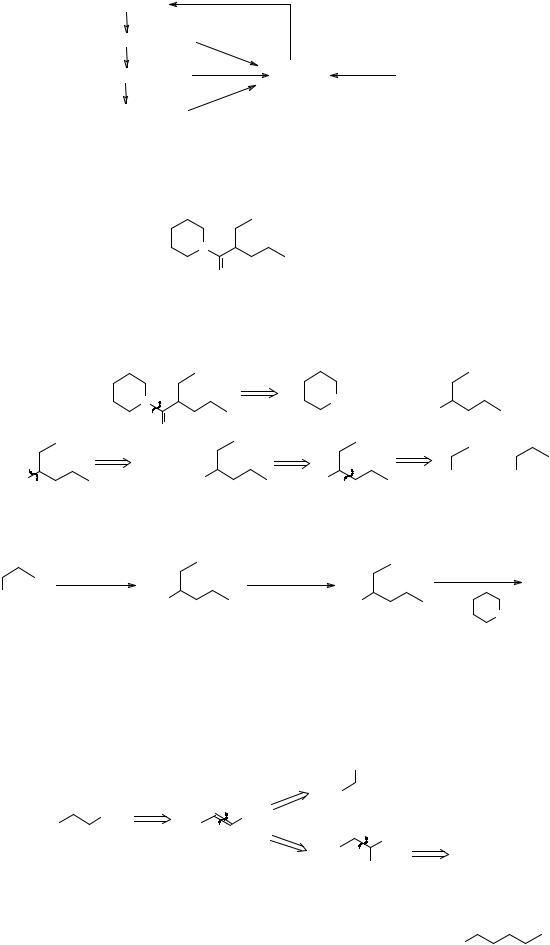
22
RCOCl
SOCl2
or PCl5
RCO . O . COR
RCO . OR ' |
RCO2H |
RMgBr + CO2 |
RCO . NR2' hydrolysis
_________________
______________________
67. So how could you make this acid derivative?
N
TM 67
O
_______________________________________
68. Analysis: Amide FGI back to carbo-xylic acid: acid is branched at
α-carbon |
use |
|
|
|
+ |
disconnection of α |
N |
|
|
||
|
|
NH |
|||
bond |
|
O |
|
|
|
|
|
|
|
|
|
|
|
CO2 |
+ |
FGI |
|
|
|
|
|
||
HO2C |
|
|
BrMg |
|
HO |
Synthesis: |
|
|
|
|
|
|
|
|
|
1. PBr3 |
|
|
1. Mg, Et2O |
|
|
2. Mg, Et2O |
|
Br |
2. EtCHO |
HO |
|
3. CO2 |
HO2C |
_______________________________________
HO2C
+
CHO MgBr
1. SOCl2
TM 67
2.
NH
69. Finally in our treatment of one group disconnections we ought to consider how to synthesise fully saturated hydrocarbons - compounds with no FG at all! These are often made by hydrogenation of a double bond, and so the disconnection can be made anywhere we like:
|
|
|
|
+ PPh3 |
+ |
|
|
|
FGI |
a |
R1 |
R2CHO |
|
|
R2 |
R2 |
|
|
|
|
R1 |
R1 |
|
|
|
||
|
|
|
R2 |
|
||
|
|
|
|
R1 |
b |
|
|
|
|
|
|
R1CH2MgBr + R2CHO |
OH
Using our principles for good disconnections, we shall obviously look for two roughly equal recognisable fragments. So how would you make TM 69?
TM 69 |
Ph |

23
_______________________________________
70. Analysis: There are many answers. One is to put the double bond as close to the benzene ring as possible:
FGI |
+ |
+ |
CHO |
|
|||
Ph |
Ph PPh3 |
|
Synthesis:
|
1. PPh3 |
|
|
n-BuCHO |
H2 |
- Pd - C |
|
PhCH2Br |
|
Ph |
PPh3 |
|
Ph |
|
TM 69 |
|
|
|
|||||
2. base |
|
||||||
|
|
|
|
|
|
|
|
______________________________________
71. A guide we can sometimes use, particularly if we use disconnection b in frame 69, is to put the OH group at a branch point in the molecule, knowing that disconnection will be easy there. Try this:
TM 71
_______________________________________
72. Analysis: Use branch point • as a guide.
MgBr
OH
O
Synthesis:
|
|
1. Mg , Et2O |
|
1. H3PO4 |
||
PhBr |
|
|
OH |
|
TM 71 |
|
|
|
|
||||
2. |
O |
2. H2 |
- Pd - C |
|||
|
||||||
_______________________________________
8. SUMMARY AND REVISION
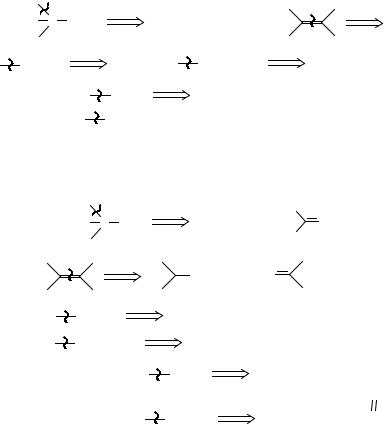
24
73. Although you have analysed the synthesis of many compounds and considered mechanisms of many reactions, we have collected only a handful of important one group disconnections. Can you fill in the details of these:
|
R1 |
|
|
|
1. Alcohols |
R2 C OH |
? |
2. Olefins |
? (name needed) |
|
R3 |
|
|
|
3. Acids |
R CO2H |
|
? |
R CH2CO2H |
? |
4. Carbonyl Compounds |
Ar |
COR |
(name needed) |
|
|
|
|
R |
CH2COR |
|
|
_______________________________________
74.
|
|
R1 |
|
|
|
R2 |
|
|
1. Alcohols |
|
R2 C |
OH |
R1MgBr |
+ |
|
O |
|
|
|
R3 |
|
|
|
R3 |
|
|
|
|
|
|
|
|
|
|
|
2. Olefins |
|
|
|
+ |
+ |
O |
|
Wittig |
|
|
|
PPh3 |
|
||||
3. Acids |
R |
CO2H |
|
RMgBr |
+ |
CO2 |
|
|
|
R |
CH2CO2H |
RBr |
+ |
CH2(CO2Et)2 |
|
||
4. Carbonyl Compounds |
Ar |
COR |
|
ArH |
+ |
ClCOR Friedel-Crafts |
||
|
|
|
|
|
|
|
|
O |
|
|
|
R |
CH2COR |
|
RBr |
+ |
EtO2CCH2CR |
_______________________________________
75. We have three or four ways to recognise a good disconnection. Make a list of these.
_______________________________________
76.
1.Good mechanism.
2.Greatest possible simplification.
3.Gives recognisable starting materials. (You might also have mentioned the use of the branch point as a guide).
_______________________________________
77. A useful thing to do at this stage would be for you to start making a chart, of your own design and for your own use, showing all the useful synthetic links between the various classes of compound. You can then add to this later but a colourful, well designed chart of the relationships between single functional groups is a good reference.
_______________________________________
9. REVIEW PROBLEMS

25
78. Review Problem 4 This compound (TM 78) is an important intermediate in the synthesis of alkaloids: Treatment with POCl3 gives the poppy alkaloid papaverine. How would you make TM 78 from simple starting materials?
OMe
OMe
MeO
TM 78
HN
MeO
O
79. Analysis: There are four ether groups, but they are peripheral and easily made. The key FG is the amide which we must disconnect first at the C-N bond. Both acid and amine could be made from the same nitrile.
|
|
|
OMe |
|
|
C - N |
MeO |
|
OMe |
FGI |
RO |
+ |
|
|
|||
|
|
|
|
|
|
FGI |
MeO |
NH2 |
|
|
RO |
|
|
|
|||
|
|
HO2C |
|
|
|
|
Cl |
|
|
|
|
RO |
|
RO |
H |
|
|
|
|
RO |
+ |
CH2O |
|
RO |
|
|
|
|
|
Synthesis: from readily available catechol: |
|
|
|
||
HO |
base |
MeO |
CH2O , HCl |
MeO |
|
|
|
|
|||
HO |
Me2SO4 |
MeO |
AcOH , 80% |
MeO |
|
|
|
|
|||
MeO |
CN |
LiAlH4 |
MeO |
|
|
|
|
|
|
|
|
MeO |
|
|
MeO |
NH2 |
|
|
|
|
|
||
|
KOH |
|
|
|
|
|
H2O |
|
|
|
|
|
|
COCl |
MeO |
|
|
MeO |
|
COCl |
|
COCl |
|
CO2H |
|
|
|||
|
|
|
|
|
|
MeO |
|
B |
MeO |
|
|
|
|
|
|
|
|
CN
Cl
NaCN
H2O , EtOH
A
TM 78
The reaction giving A is 'chloromethylation', a reliable method of adding a CH2OH equivalent to an aromatic ring. You may have been surprised at the use of reagent B to make an acid chloride. B is oxalyl chloride and is often used when pure acid chlorides are wanted - the other products are gases (which?).
The nitrile is described in a patent (Chem. Abs., 1955, 15963); the last stages were carried out by A. R. Battersby's research group at Cambridge. Chloromethylation is described in Tedder, Vol 2, p.213 and Norman P.372-3.
_______________________________________
80. Review Problem 5: 'Brufen' (TM 80), Boots anti-rheumatic compound, is one of Britain's top ten drugs. How could it be made?
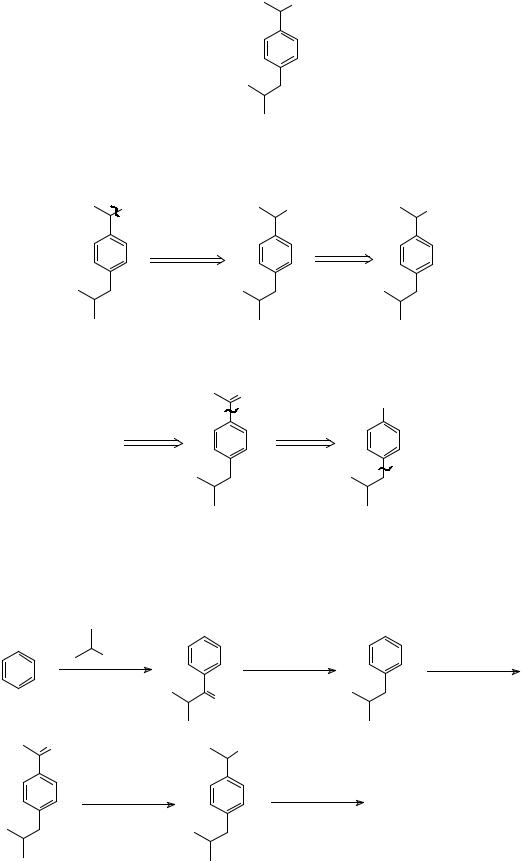
26
CO2H
TM 80
_______________________________________
81. Analysis: The carboxylic acid is the only FG so we can start there:
CO2H |
Br |
OH |
|
|
FGI |
|
cyanide or |
|
|
Grignard |
|
We now have a benzyl alcohol so we use Friedel-Crafts rather than Grignard:
O
H
FGI |
FC |
Again we want to use Friedel-Crafts but we must use acylation rather than alkylation or we shall get rearrangement.
Synthesis: This is one possible approach - we don't actually know how it is done.
COCl |
Zn - Hg |
MeCOCl |
|
AlCl3 |
conc. HCl |
AlCl3 |
|
|
O |
|
|
O |
Br |
|
|
1. NaBH4 |
1. Mg, Et2O |
Brufen |
|
2. PBr3 |
2. CO2 |
||
|
_______________________________________
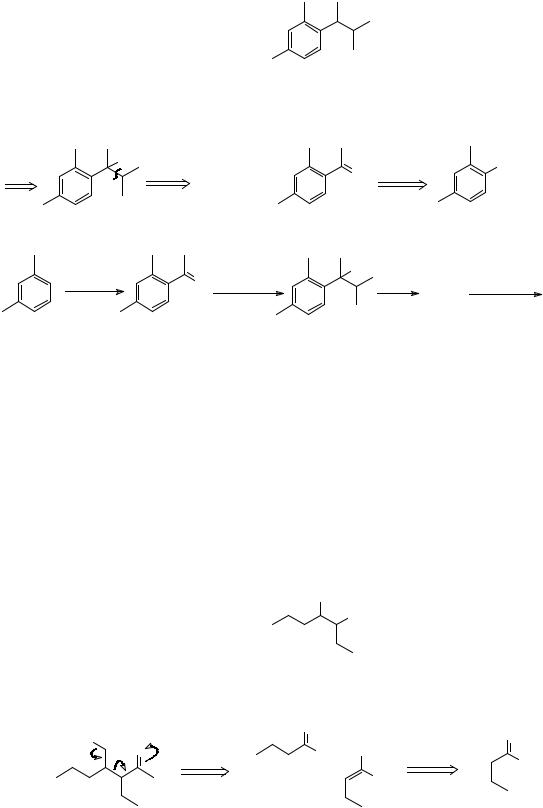
27
82. Review Problem 6: Some chemists who were investigating the possibility of reversible Friedel-Crafts reactions, wanted an activated aromatic ring connected to a branched alkyl chain and chose to make TM 82 . How would you do it?
TM 82
_______________________________________
83. Analysis: Using the branch-point, in the largest side chain as a guide, we can put in a hydroxyl group (as in frame 72).
OH |
|
FG |
H |
|
|
O |
|||
i - PrMgBr + |
+ MeCOCl |
|||
|
||||
|
|
Synthesis: hote that there is only one activated site for the Friedel-Crafts reaction – o and p to the two methyl groups but not between them for steric reasons:
MeCOCl |
|
OH |
|
|
O i - PrMgBr |
H+ |
H2 |
- Pd - C |
|
|
|
olefins |
|
TM 82 |
AlCl3
This was essentially the method used by the chemists who went on to investigate the chemistry of TM 82 (J. Org. Chem. 1942, 7, 6).
_______________________________________
C. TWO-GROUP DISCONNECTIONS
1. 1,3-DIOXYGENATED SCELETONS
(a) β-HYDROXY CARBONYL COMPOUNDS
84. When a molecule contains two functional groups, the best disconnection uses the two together. So if you consider TM 84 as an alcohol, and use the carbonyl group to guide your disconnection, what do you get?
OH
CHO
TM 84
_______________________________________
85.
H |
O |
O - |
O |
|
|||
O |
H |
H |
|
|
A |
|
|
|
|
H |
|
|
|
|
|
|
|
B |
|
The anion B is just the enolate anion of a carbonyl compound, actually the same as A. So there is no need to use a Grignard reagent or any other synthetic equivalent in this reaction: anion B itself can be the intermediate and we simply treat the aldehyde with mild base:
